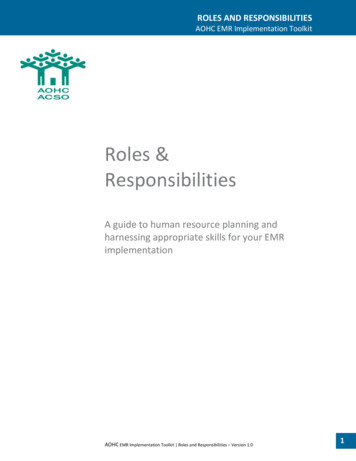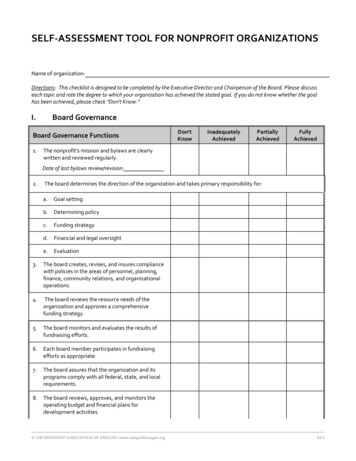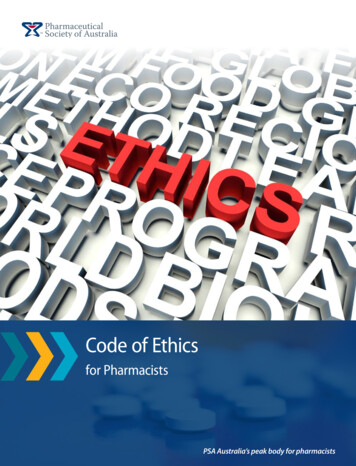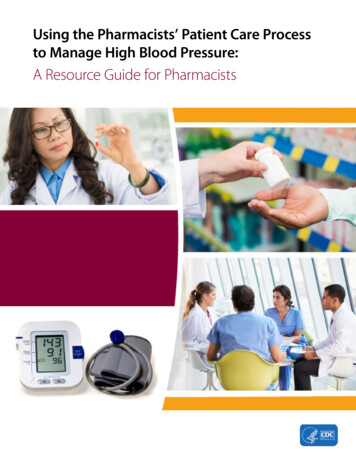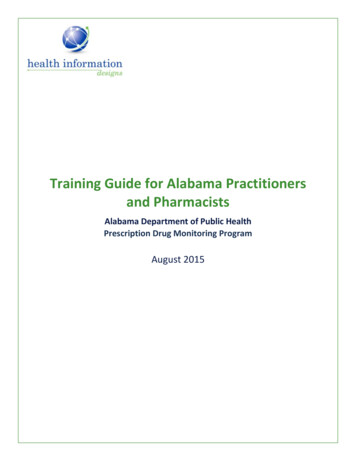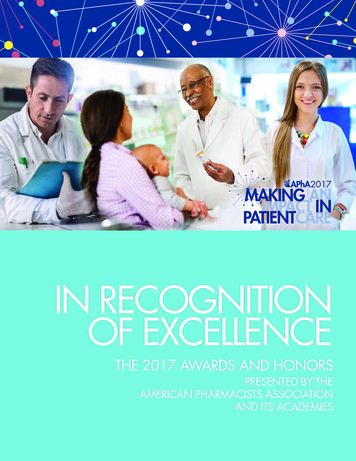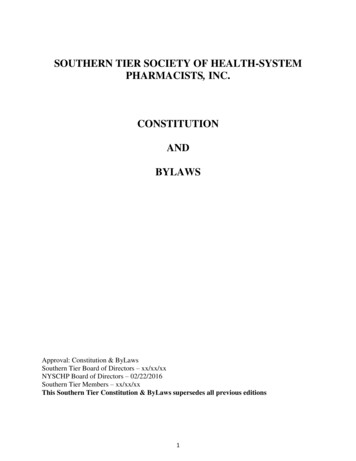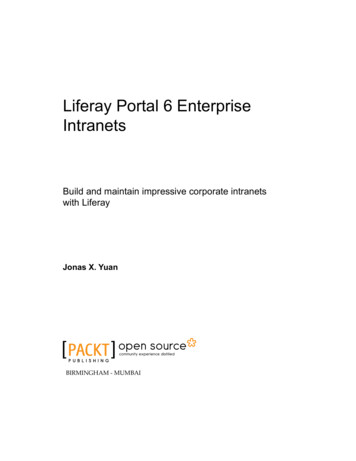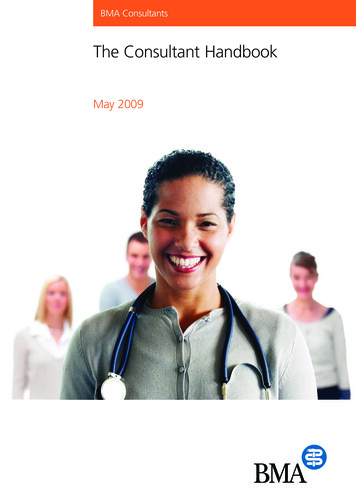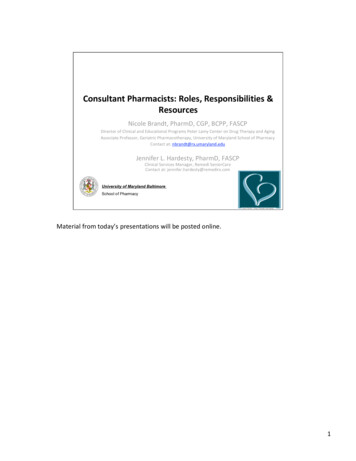
Transcription
Consultant Pharmacists: Roles, Responsibilities &ResourcesNicole Brandt, PharmD, CGP, BCPP, FASCPDirector of Clinical and Educational Programs Peter Lamy Center on Drug Therapy and AgingAssociate Professor, Geriatric Pharmacotherapy, University of Maryland School of PharmacyContact at: nbrandt@rx.umaryland.eduJennifer L. Hardesty, PharmD, FASCPClinical Services Manager, Remedi SeniorCareContact at: jennifer.hardesty@remedirx.comUniversity of Maryland BaltimoreSchool of PharmacyMaterial from today’s presentations will be posted online.1
What are the Regulations in Marylandsurrounding Medication Management?Access them .htmThis was reviewed in the morning sessions so please refer to those notes.2
10.07.14.29 MedicationManagement and Administration Residents who Self Administer Medications:– AL manager must ensure assessment is completedupon admission which states they are able to selfmedicate– Quarterly evaluation must be completed by thedelegating nurse to ensure that they are still safeto self medicateWhen patients are admitted into ALFs, how do we assess whether or not theyare capable of self-administration of medications? Who checks this?Nurses do. Download form for assessment online from Board of Nursingwebsite.85% of patients in ALF need help with medications.Medication self-administration decisions are considered a gray area due tomany reasons -including financial, social, safety and medical aspects. Manypatients do not want to lose their sense of autonomy. Still, many patients arereally not able to self administer due to tactile, memory or cognitive difficulties.Patients cannot self-administer some of their medications: it is either all ornothing.3
Medication Review UponAdmission The AL manager shall consult within 14 daysof a resident’s admission with the followingindividuals who can conduct a medicationreview:–––––Primary Care PhysicianCertified registered nurse practitionerCertified registered nurse midwifeRegistered nurse, who may be the delegating nurse orLicensed pharmacist.It is good practice for ALFs to contact a team to conduct a medication reviewupon admission of a new resident. Transition stages between discharges andadmissions into ALFs are the most likely times for medication errors. Most ofthe problems arise from communication issues between the hospital and ALFstaff. In order to prevent readmissions and to stabilize care, it is also best toinvolve a pharmacist or team from the very beginning.One of the major concerns is medication reconciliation and making sure allmedications are necessary and appropriate.4
Purpose of this Review Is to review with the AL manager or designee:– A resident’s current medication profile, including allprescription and non prescription medications andfeedings– The potential that current medications have to act aschemical restraints– The potential for any adverse drug interactions,including potential side effects from the medications and– Any medication errors that have occurred sinceadmission.5
Pharmacy Review The AL manager shall arrange for a licensedpharmacist to conduct an on‐site review ofphysician prescriptions, physician orders andresident records at least every 6 months forany resident receiving 9 or more medicationswhich include over the counter and asneeded medications.Poll of audience indicates that most sites would like the pharmacist to come inand review all patient charts. Other sites ask pharmacists to only reviewpatients with 9 medications or more, for financial reasons.6
The Pharmacist’s Review Shall include but is not limited to, whether:– Program is in compliance with Board of Pharmacy’s requirements for packaging ofmedications– Each resident’s medications are properly stored and maintained– Each resident receives the medications that have been specifically prescribed for thatresident in the manner that has been ordered.– Based on available information, the desired effectiveness of each medication isachieved, and, if not, that the appropriate authorized prescriber is so informed;– Any undesired side effects, potential and actual adverse drug reactions, and medicationerrors are identified and reported to the appropriate authorized prescriber;– The resident has a medical condition as documented in the resident's records that isnot currently being treated by medication;– There is drug use without current indication in the resident's records of a medicalcondition that warrants the use of the drug;Resources can be found at http://www.geri-ed.umaryland.edu/ . (MedicationManagement)There is a webinar post for families. The page also has a downloadable ALFmedication review checklist, which goes through COMAR regulations.Among other things, the pharmacist makes sure schedule II drugs are doublelocked. He/she also reviews medication carts to make sure recalls and expiredmedications are properly disposed of.All types of medications are included in the 9 medications qualification –including Rx, herbal, OTC, PRNs.Common issues:- OTCs: always problematic because they are less likely to be reported (andcan, for example, result in Tylenol toxicity, drug-drug interactions )- Monitoring: many adverse effects occur because of poor monitoring.Pharmacists can make a big impact by educating other health carepractitioners on monitoring of drugs.- Acquiring laboratory work is a tedious and time consuming task, but is vitalfor monitoring and for patient safety.- Clinical Relevance: when is it, for example, clinically relevant to report andact on drug-drug interactions?The information from the pharmacist’s review should be provided to both the7
The Pharmacist’s Review cont Shall include but is not limited to, whether:There is drug overuse that is causing side effects as documented in the resident records;Current medication selections result in inappropriate drug dosage;The resident may be experiencing drug interactions;The resident is receiving medication, either prescribed or over‐the‐counter medications,as well as herbal remedies that could result in drug‐drug, drug‐food, or drug‐laboratorytest interactions;– Administration times of medication need to be modified to address drug interactions ormeal times, or both;– The resident records need to be reviewed to assure that periodic diagnostic monitoringrequired by certain medications have been performed; and– The resident's medication regimens need to be reviewed to determine if more cost‐effective medications are available to treat current medical conditions––––8
Documentation and Follow‐up The pharmacist shall document the pharmacy review asrequired under this section in each resident's chart and thisdocumentation shall be reviewed every 6 months as part ofthe assisted living program's quality assurance activities asrequired in Regulation .13 of this chapter. The person conducting the on‐site review under §F or I of thisregulation shall recommend changes, as appropriate, to theappropriate authorized prescriber and the assisted livingmanager or designee.9
Roles and Responsibilities10
1. Perform a Medication Regimen Review(MRR) What is MRR?– “Thorough evaluation of the medication regimenof a resident, with the goal of promoting positiveoutcomes and minimizing adverse consequencesassociated with medications; The review includespreventing, identifying, reporting, and resolvingmedication‐related problems (MRPs), medicationerrors, or other irregularities and collaboratingwith others members of the interdisciplinaryteam.”Centers for Medicare and Medicaid Services. State Operations Manutal. Appendix PP: Guidance to Surveyors for Long Term care facilities Rev. 26Accessed at www.cms.hhs.gov/manuals/downloads/som107 /som107 Appendicestoc.pdf. on October 16, 2008.
2. Provide Ongoing Education to Direct CareStaff, Residents and/or the Family Medication management is based in the careprocess and includes:– Recognition or identification of the problem/need– Assessment– Diagnosis/cause identification– Management/treatment– Monitoring– Revising interventions Centers for Medicare and Medicaid Services. State Operations Manutal. Appendix PP: Guidance to Surveyors for Long Term carefacilities Rev. 26 , Accessed at www.cms.hhs.gov/manuals/downloads/som107 /som107 Appendicestoc.pdf. on October 16, 2008.12
Diagnostic Monitoring Physician Orders & Communication of Results– Is there an existing physicians’ order for lab monitoring and if so, is itbeing followed?– Ask for copies of lab reports and place in residents chart Monitoring for Common Medical Conditions andMedications– Type II Diabetes– High Blood Pressure– Dementia Potentially Problematic Medications– Narrow Therapeutic Medications: Warfarin (Coumadin),Digoxin,Carbamazepine (Tegretol),Lithium,Theophylline,Levothyroxine (Synthroid), &Valproic Acid (Depakote) 13
3. Assist with Assessing Resident’s abilityto Self Administer Medications Various screening and assessment tools to evaluate aresident’s ability to self medicate.e.g., MediCog: evaluates the ability to set up a pillbox Two Part Screen Mini‐Cog: detects clinically significant cognitive impairment Medication Transfer Screen (MTS): evaluates skills in decipheringprescriptions and ability to sequence and locateAnderson K, Jue SG, Madaras‐Kelly KJ. Identifying Patients at Risk for Medication Mismanagement: Using Cognitive Screens to Predict a Patient’s Accuracyin Filling a Pillbox. Consult Pharm 2008;June;23(6):259‐7214
Medi‐Cog MethodThis is a good tool to assess self-medication ability.15
Resources16
Medication Management in Assisted Living Facilitiesweb based seminar & Resources Intent of this webinar is to increase the knowledge ofhealthcare professionals, facilities and families to thecomplexity of medication management issues that exist inALFs. Interdisciplinary Faculty:– Nicole Brandt, PharmD (pharmacy),– Barbara Resnick, PhD, CRNP (nursing),– Richard Stefanacci, DO (medicine) and– Jacqueline Pinkowitz, M Ed. (consumer advocacy). Launched July 2009 & CEAL award recipient The web page address is: http://geri-ed.umaryland.edu.This webinar is now available at the Medication Management for Older Adultswebsite at, medmanagement.umaryland.edu .17
Work Group UM School of Pharmacy is spearheading a multifacetedapproach to improving medication management andultimately care to residents in Assisted Living through acollaborative workgroup: Workgroup members:– Pharmacy, Nursing and Medicine faculty– Representatives from the: Boards of Pharmacy and Nursing,Office of Healthcare Quality,Lifespan andGeriatrics and Gerontology Education and Research Program.The intent of this workgroup is to educate healthcare professionals,ALF staff as well as policy makers on the issues of medicationmanagement in ALFs.In addition, the group will be evaluating the impact of the newregulations, focusing on pharmacy issues and the role of consultantpharmacists in terms of medication related problems, patient safetyand costs.18
Resources Lifespan– www.lifespan‐network.org/ American Society of Consultant Pharmacists– www.ascp.com– ex.cfm Center for Excellence in Assisted Living:– www.theceal.org Consumer Consortium on Assisted Living– www.ccal.org19
Helpful Websites For Information on AssistedLiving and Geriatrics American Medical Director’s Association– www.amda.com American Association of Retired Persons– www.aarp.org National Center for Assisted Living– www.ncal.org The American Geriatrics Society– www.americangeriatrics.org Assisted Living Info– www.assistedlivinginfo.com Assisted Living Federation of America– www.alfa.org2020
Resources MTMS and the Million Dollar Question: How WillALF Residents s/01‐03/ALC1‐3 MTMS.pdf Primer for Medication Management: WhatPractitioners Need to Knowhttp://www.theceal.org/downloads/CEAL 1183488426.pdf21
Case Discussion22
Case 91 yr old male who is new to the AssistedLiving Facility. There is limited information onhis past medical history and he is not a goodhistorian. He states he lived on farm andreceived little medical care in the past. Henotes he is not happy with his move into thefacility. One of the concerns from the medical team isthe use of his medications with hisconcomitant Hepatitis and impaired liverfunction.23
Past Medical History & LabsPast Medical History: Dyslipidemia Type II DiabetesMellitus Coronary Artery Disease h/o Hepatitis C Benign ProstaticHypertrophyLabs on Admission : AST: 179 ALT: 103 Alk Phos: 185 Alb: 3 HgA1C: 7.9% Hep C positive BMP & CBC: WNL (Cr 1.0)24
Medication List Metformin 500mg 1 tablet twice dailyGlipizide 10mg 1 tablet twice dailyLantus 10 units in the eveningSimvastatin 40mg in the eveningLisinopril 10mg in the morningMedication related issues:1)Type II DM: In light of his age as well as his hepatic dysfunction, I wouldrecommend stopping Metformin and Glipizid and just keep him on Lantus.Increase the Lantus dose to 12 units, monitor and then optimize further (this isa conservative increase based on limited BS when the two medications arestopped). In light of his age, we just want to maintain his HgA1C 8% ifpossible. Both Metformin and Glipizide should be used cautiously in hepaticdysfunction.2) Dyslipidemia: In light of his hepatic dysfunction, I would recommendstopping the statin.3) Monitor his liver function quarterly. We may also want to monitor hisPT/INR.4) Depression; May consider referring him to a psychiatric for a follow-up.5) h/o BPH; The patient had been tried on various medications for BPH but didnot tolerate them. Not sure what the agents were though. Will defer to urologyfollow-up.6) Health Maintenance; Consider starting an ASA 81mg daily.25
Where is this patient in thecontinuum of care?A. Primary & Secondary PreventionB. QOL/Reduce Acute ExacerbationC. EOL / Comfort CareA. Primary and secondary care in a 91 year old: more important to ask whatthe patient would like and what his/her family wants.26
Which of the following medication(s)would you plan to discontinue?A.B.C.D.E.Metformin 500mg 1 tablet twice dailyGlipizide 10mg 1 tablet twice dailyLantus 10 units in the eveningSimvastatin 40mg in the eveningLisinopril 10mg in the morningUltimately, the patient was kept on Lantus 12 units in the evening andLisinopril 10mg in the morning. The rest were discontinued.27
How would you monitor thispatient?A.B.C.D.E.Check finger sticks three times a dayCheck HgA1C quarterlyCheck lipid panels every 3 monthsAll of the AboveNone of the AboveStopping medications is just as important as starting medications and stoppingmonitoring labs is just as important as starting them.In the long run, the patient would not need finger sticks and HgA1c testingonce glucose stabilizes, and lipid panels will not be needed since Simvastatinwas stopped.28
Nicole Brandt, PharmD, CGP, BCPP, FASCPAssociate Professor, Geriatric PharmacotherapyUniversity of Maryland School of Pharmacynbrandt@rx.umaryland.edu29
The University of Maryland, School of Pharmacy has been leading an Assisted LivingFacility Workgroup made up of stakeholders such as faculty, long term care pharmacists,Boards of Pharmacy and Nursing representation, Geriatrics and Gerontology Educationand Research Program as well as Office of Healthcare Quality staff to advance educationand research regarding medication management in ALFs. The University of Maryland,School of Pharmacy is interested in collecting data on what pharmacists are finding whenthey are conducting their medication reviews. In addition, a standardized checklist hasbeen developed with an educational webinar to help pharmacists meet the regulationsand provide adequate documentation. If you are interested in learning more, please feelto contact Dr. Brandt at nbrandt@rx.umaryland.edu as well as visit the http://geri‐ed.umaryland.edu to have access to the educational tools under the MedicationManagement section.University of Maryland BaltimoreSchool of PharmacyKeep in touch ).Thank you!30
-Certified registered nurse practitioner -Certified registered nurse midwife -Registered nurse, who may be the delegating nurse or -Licensed pharmacist. It is good practice for ALFs to contact a team to conduct a medication review upon admission of a new resident. Transition stages between discharges and
